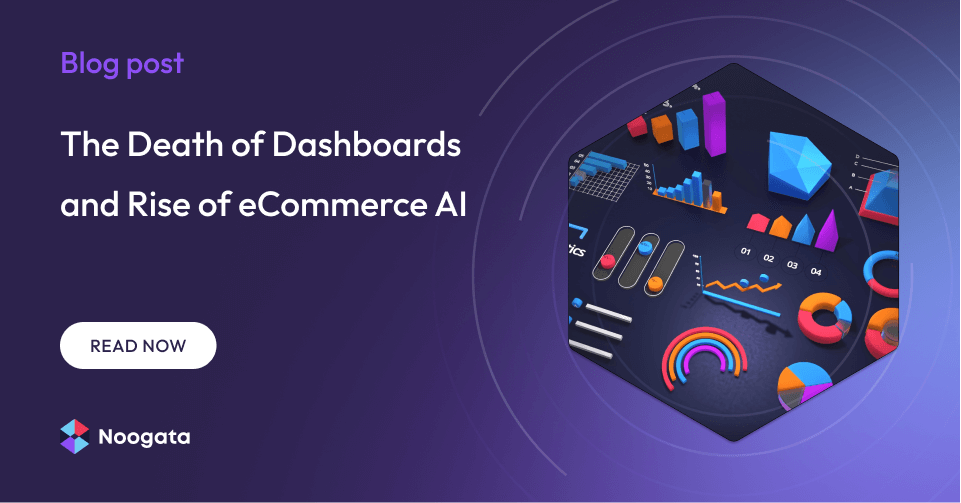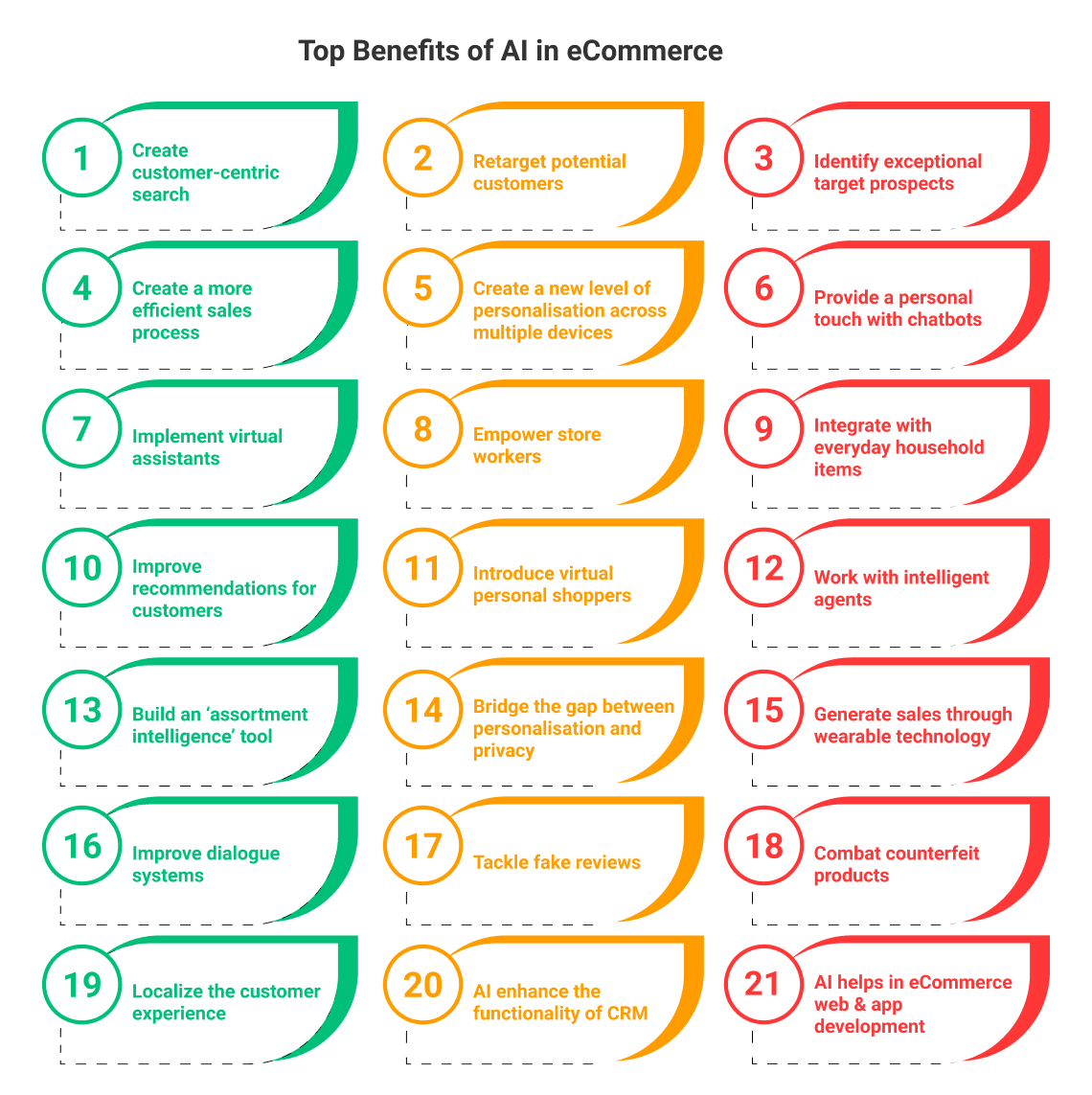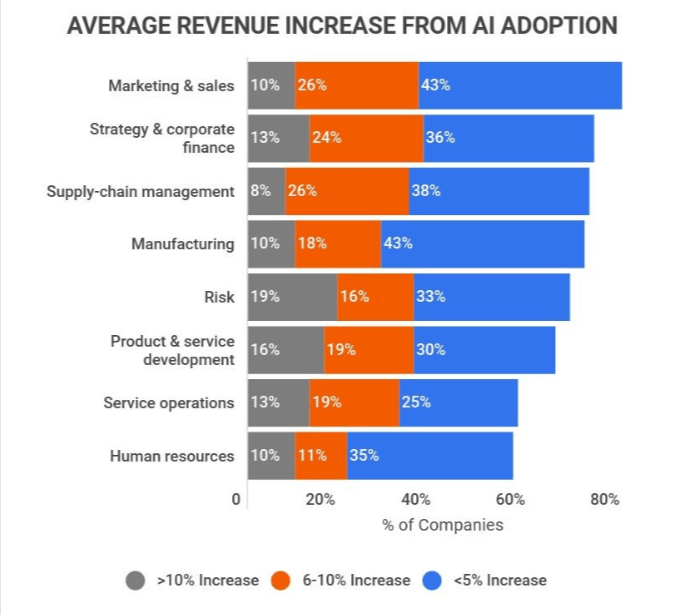Dashboards have been widely used and valued for visualizing and communicating data for many years. They were the primary tool organizations relied on to make significant amounts of data accessible to humans. Even today, data and BI teams spend significant time building dashboards to meet the diverse demands of stakeholders who require different representations of key performance indicators (KPIs) and metrics.
However, in recent years, several ambitious vendors and data experts have claimed that dashboards are no longer relevant—or dead. While this statement is exaggerated, it is clear that dashboards alone are insufficient for businesses like eCommerce brands. Instead, these businesses are turning to AI tools to enhance existing dashboards or entirely replace them with user-friendly andAI-powered eCommerce solutions leveraging generative AI.
While dashboards are growing less effective and attractive, AI is taking the eCommerce world by storm. In 2021, 73% of retailers planned to employ AI to optimize product pricing, while retail and consumer products executives projected that intelligent automation capabilities could help increase annual revenue growth by up to 10%.
What does this mean for dashboards in eCommerce? Are they really dead? And how will AI make our jobs more manageable rather than take them away? Before answering these questions, let’s review why your traditional static dashboards should be promptly archived away.
Why We Need to Retire Traditional eCommerce Dashboards
News flash: dashboards are not dead. They are still a powerful tool in providing data consumers with a high-level overview of trends and changes in key metrics they care about. Dashboards help measure and track metrics but fail to provide intelligent analysis, context, and actionability to the data they visualize.
For example, a dashboard may help visualize trends in specific categories over time. Still, it will never offer strategies on what to do next, or suggest how retailers can boost ads for particular keywords to help increase product visibility to ultimately grow revenue.
When it comes to the unique needs of brands and CPGs in eCommerce, dashboards are painfully limited in their ability to turn data into actionable insights for numerous reasons.
Data Teams Burnout and “eCommerce Dashboard Fatigue”
To make dashboards valuable to their users, they need to be built and customized to the needs of their specific users. This process, often iterative and lengthy, can end up producing a “trashboard“—a dashboard that is viewed once and never used again. No one likes spending time and energy making something that doesn’t deliver value, especially when they can use this time to perform tasks that help turn data into business value, like data discovery and preparation.
Moreover, designing dashboards that visualize all relevant metrics without creating a cluttered and overwhelming interface can make or break their usability and ability to deliver value to the user and the business.
The sheer number of dashboards—and the energy and skill necessary to derive actionable insights from them—is causing eCommerce dashboard fatigue and impairing our ability to take timely data-driven action.
The fatigue has two sources: first, eCommerce dashboards do offer insights and value into metrics and trends—but the manual, data intensive work to derive them requires an eCommerce expert or data scientist.
Secondly, dashboards are reactive, requiring time for data collection, analysis, and insights. To be proactive rather than reactive, professionals must embrace AI, which enables them to anticipate market changes before they occur—and to derive value and insights in real-time and without having to manually parse the data themselves.
Lacking Data Integration and Scalability
eCommerce sellers and brands aggregate and process data from multiple sources. These include (but are not limited to) client databases, social media channels, third-party public data sources, inventory systems, and web and mobile analytics.
Integrating a growing number of disparate sources and displaying the results quickly in a unified, meaningful way is challenging, to say the least. This is especially true if the data is not standardized or suffers from the kind of data quality issues that can make dashboards unreliable or altogether useless.
Ecommerce dashboards can face scalability issues due to limitations in processing large volumes of data, integration challenges, handling concurrent user demands, and providing real-time insights. To address these challenges, businesses can explore cloud-based solutions, leverage AI, and adopt real-time data integration techniques. These approaches enable scalability and support the growing needs of expanding ecommerce operations.
No Context and Slow Reaction Times
eCommerce is a highly dynamic environment where timely (and sometimes near-real-time) access and response to major market changes are critical. Any delays in fetching data can hinder our ability to make tactical decisions in response to market fluctuations and evolving consumer trends.
Another cause for costly delays is the time it typically takes decision-makers to transform the visualized data into insights that drive actions. By the time a significant market trend is visible on a static dashboard, your competitors may have already detected it and capitalized on it.
Dashboard-driven decision-making processes are slow, reactive, resource-consuming, and can only help you find the data you’re already looking for. Dashboards can’t see beyond the scope of what they are defined to visualize.
So what does it take to leverage eCommerce data’s ever-growing expanse and potential for business growth?
- Superhuman speed and availability – When it comes to large brand eCommerce operations and multi-channel sellers, every minute you ignore shifts in the market will cost the business money. You need to be able to detect (or even forecast) the shifts and respond to them immediately.
- Genius-level comprehensiveness – The number of data points and metrics to consider when making business decisions grows daily. You are expected to “connect the dots” across more sources than you can keep track of to turn them into meaningful insights.
- Strategic Actionability – When data is forced to live in a dashboard, it rarely drives actions that create business value. Even when the data users fully understand the metrics on the dashboard, they often fail to answer the question: “Yes, but what should we do now?”
Clearly, no individual human or team can keep up with these demands cost-effectively and at scale, especially with rising volumes of data. Nor for you and not for your competitors. What can? The online seller’s new best friend—eCommerce generative AI.
Harnessing AI for eCommerce Growth
While AI is not due to replace data analysts or dashboards anytime soon, it can enhance data-driven decision-making, as well as the overall BI and competitive intelligence capabilities of any organization.
AI solutions designed and trained for eCommerce business applications can offer more than that. They complement the dashboards (which may still be used for high-level monitoring and tracking specific KPIs) with interactive and innovative capabilities. AI can be used in addition or in lieu of outdated, data heavy previews. Instead, AI remagines creativity, strategy, productivity and harnesses that towards achieving any objective you give it. The actual opportunities are endless if used correctly.
Outside the technical aspects, AI allows anyone to find insights and strategies in their data without needing to be a trained data scientist. By essentially making everyone an Ccommerce expert by doing the complex work for them in the background, eCommerce AI solutions become a time (and life) saver that works even better as more data is fed into the AI—and with that data, will evolve from what now is a complementary tech piece to dashboards to their eventual replacement.
Real-time Analytics and Automation
An AI engine never sleeps or takes lunch breaks or sick leaves. You can use AI models to process and analyze multiple data streams to find patterns and discover emerging opportunities in near-real time. For example, Noogata’s Search Trendspotting feature leverages AI to discover keyword opportunities for Amazon sellers.
Sometimes, you can even automate the response to changes detected to capitalize on opportunities before they lose relevance (or your competitors capitalize on them first). If you don’t trust AI to automatically change the content or pricing of the products on your digital shelf, that’s okay—you can set the AI to alert you instead.
Insight Generation and Data Accessibility
One of the main issues with dashboard-driven decision-making is the challenge of answering the earlier question: “What should we do based on all this data? How is this insight valuable?”
AI models can analyze vast volumes of data to generate actionable insights to adjust pricing, optimize product page content for better product discovery, boost ad campaigns, and more. With ChatGPT-like natural language processing (NLP), data consumers and stakeholders can get actionable answers to their business questions without needing to search through dashboards (or build an expensive in-house AI solution).
For example, instead of spending hours staring at multiple dashboards and applying various filters to them, Noogata’s AI assistant proactively delivers growth opportunities presented as insights in real-time.
Predictive Analytics and Simulation
In an arena as dynamic as eCommerce, it makes sense to invest resources to stay ahead of the curve. AI models excel at processing historical data from various sources to predict, cross-reference and forecast future outcomes.
For eCommerce businesses, AI can forecast product demand, simulate sales growth with different ad budgets while predicting expected inventory levels, and look for insights that disappear in the depth of data-heavy dashboards. For example, Noogata can monitor sales in real time then deliver strategies to help grow or improve sales without guessing on the next steps to success.
Beyond the Forecast: Predicting the Future of AI in eCommerce
The shift from endless dashboards to easily accessible and automated insight generation has brought a breath of fresh air to the offices of data analysts for brands and eCommerce professionals everywhere.
For eCommerce sellers and global CPG brands, AI holds nearly infinite potential to optimize ROIs across the digital shelf and buyer journey, benefiting everyone involved—and most importantly, the customer buying online.
It’s no wonder that retail giants like Walmart and Amazon are quick to jump on the AI bandwagon, employing it to do much more than just replace dashboards. As AI-driven tools and technologies continue to advance, they will enable brands and eCommerce businesses to enhance the customer experience while growing their bottom line.
CPG brands and eCommerce sellers cannot afford to ignore the advantages eCommerce AI can bestow upon their competition. To remain competitive in 2023 and beyond, businesses looking to leverage data to grow revenues and lower expenses should start by replacing dashboard-driven decision-making processes with AI solutions that can provide actionable data-driven insights to business questions.






